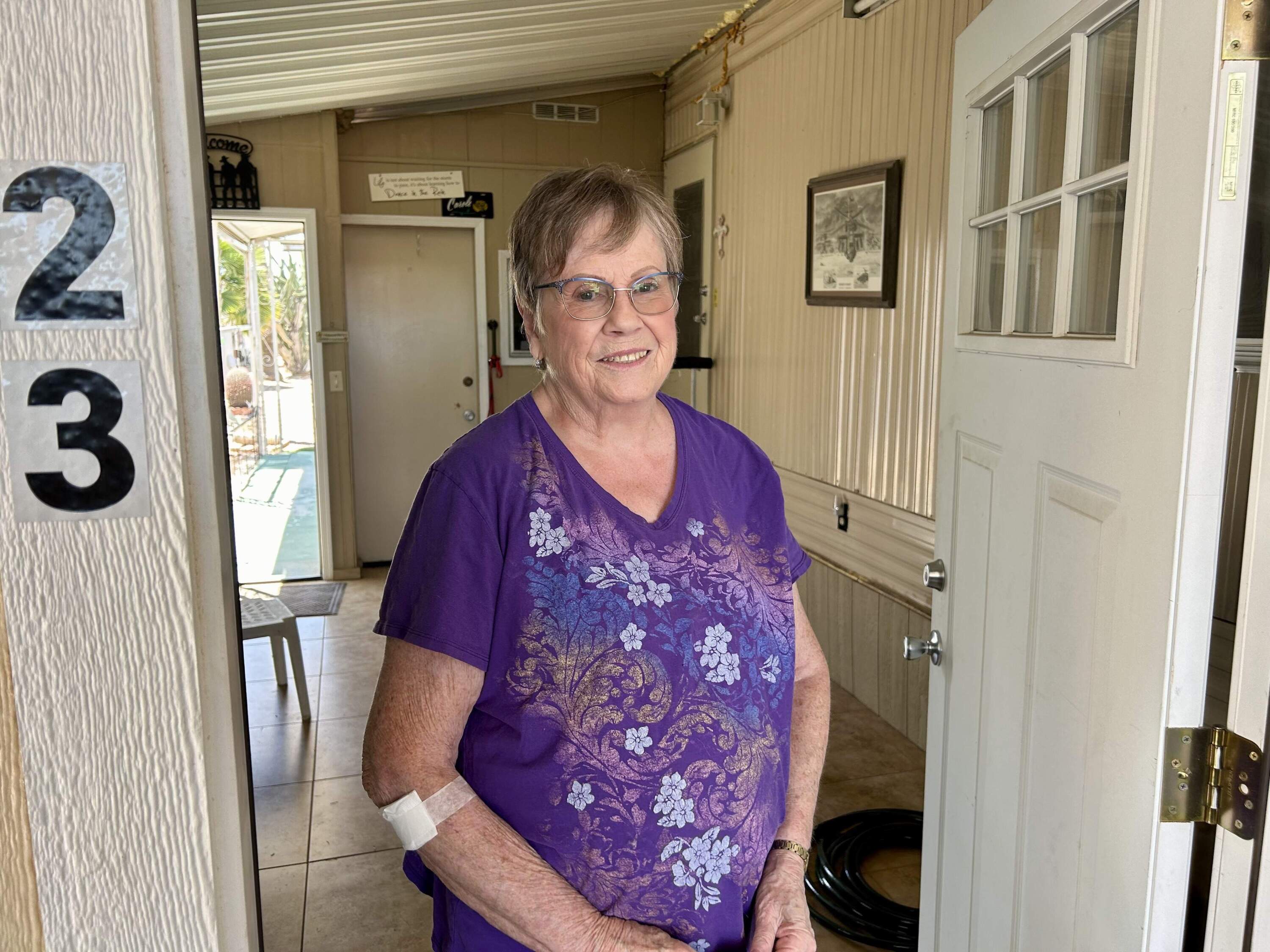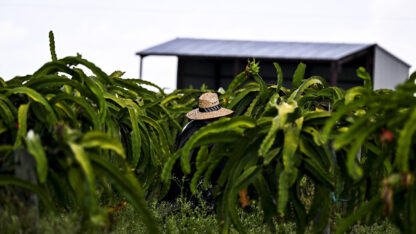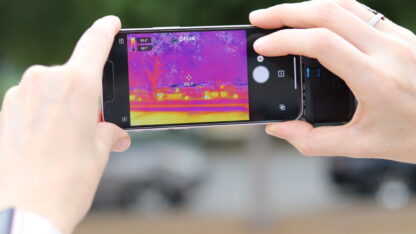Last August, an elderly man named Ronald Davies was at home with his sick wife in the Phoenix suburb of Chandler. It was summertime. Their air conditioning unit had recently broken, and when investigators finally arrived to check on them, the temperature inside their mobile home was 102 degrees.
Davies and his wife were two of the 645 people who died in last summer’s record-shattering heat, according to records from the Maricopa County medical examiner.
Nearly half of those people lived outdoors without shelter, but public health officials and lawmakers are starting to pay more attention to the risk of dying indoors.
In a city where temperatures can flirt with 120 degrees, not everyone has air conditioning — or the money to pay an electric bill.
Living without air conditioning
Carole Ann Kane was one of those people without AC.
She lives with her dog Penny in a one-bedroom mobile home in the Phoenix suburb of Mesa. Kane moved in January after a split with her husband. Her mobile home is a clean and tidy place but had no air conditioning.
Kane knew this when she moved in. But she had few options.
After her husband left, she says she unwittingly gave $30,000 to a scammer who walked away with her nest egg.
Kane’s daughters helped buy the mobile home with the little money she had left. Now she lives on $1,700 per month from Social Security to pay the bills, plus another $250 from a retirement account.

Carole Ann Kane, 82, moved into her mobile home in Mesa, Arizona in January. It did not have an air conditioning unit and Kane felt a sense of urgency to find a solution before summer temperatures soared. (Peter O’Dowd/Here & Now)
An air conditioning unit was not in the budget.
“The only thing I can do was hope and pray that we can get the money together to get an air conditioning,” Kane says. “It’s hard.”
By May, temperatures had already topped 100 degrees, and Kane was feeling “anxious and desperate” with the summer approaching.
Kane would wake up in a pool of sweat and get overheated doing the dishes. Her dog suffers in the dangerous situation, too.
“It breaks my heart to see her panting the way she’s panting,” Kane says.
Experts say the vast majority of people who die indoors in a Phoenix summer actually have AC. They just can’t afford to use it.
Kane is 82. She has asthma. She lives alone.
All these factors put her at risk, says Patricia Solis, director of the Knowledge Exchange for Resilience at Arizona State University.
“When you’re starting to compile risk upon risk upon risk, they are exponential,” Solis says.
Solis has examined heat deaths indoors in recent years and found that 30% to 40% of the heat-related indoor deaths in the Phoenix metro area happened in mobile homes, RVs and trailers. In 2023, records show that number fell to 24%.
“It very much surprised me,” she said. “It was one of those things that are hidden in plain sight.”
The region’s sunny weather has long been a draw to seniors looking for an affordable place to retire.
But across the state, Solis says her team has identified 175,000 mobile homes built before 1990. That means they likely have poor insulation or leaky windows and generally don’t live up to modern building standards.
People who live in mobile homes typically own the structure, but rent the land from the park. Solis says some park managers prohibit people from installing shade structures and have ordered residents to take the AC units out of their front windows.
“To prohibit you from using life-saving technology does not seem like something that people in Arizona would permit,” she says. “We may not agree on everything, but that seems like a no-brainer to me.”
Reform at the Capitol
In April, Gov. Katie Hobbs signed a bi-partisan bill that protects a tenant’s right to install air-conditioning window units — or other cooling technology — in a mobile home. Republican House member David Cook co-sponsored the legislation. Cook says this issue is closely related to the state’s housing shortage.
Rents have soared in recent years. Evictions are near record highs, and some people are willing to suffer without AC if it means staying in their homes.
“People are on fixed incomes,” Cook says. “Now they’re dealing with inflation. They may have their homes paid for in one of these spots — and that’s all they have. The next step is homelessness.”
Last July, Phoenix suffered 31 straight days of 110-degree temperatures. More people died of heat-related illness than ever before.
So why would any mobile home park ban a window AC unit?
At a legislative committee hearing earlier this year, a lobbyist with the Manufactured Housing Communities of Arizona answered that question.
“Historically there have been some pretty loud ones, and also they are just a bit more unsightly,” says the lobbyist, Janna Day, explaining why some parks have restricted window units.
The organization supports mobile home park owners. Here & Now reached out for further comment, but they did not respond.
Rent and heat
DeAnna Mireau kept a close eye on the bill as it moved through the legislature. She leads the Arizona Association of Manufactured Home, RV & Park Model Owners, a statewide group of mobile home park residents.

DeAnna Mireau, president of the Arizona Association of Manufactured Home Owners, says the two biggest issues in mobile home communities are rising rents and exposure to heat. She’s pictured outside her mobile home in Phoenix. (Peter O’Dowd/Here & Now)
“You know what I find more unsightly? Is watching my neighbor be removed from their home in a body bag,” she says from the front patio of her mobile home in Phoenix. “This is a life-saving bill we’re talking about.”
Mireau says the management of her park allows residents to use heat-blocking techniques, and her home looks like an oasis.
A trellis casts deep shade on the patio. A blossoming bougainvillea bush covers the tinted front window. A few years ago — when her central air broke down — she could afford a new $6,000 wall-mounted mini-split system.
But none of her precautions were enough during last summer’s record heat wave.
“You couldn’t cool the place last year,” she says.
And she wasn’t alone. Mireau says her group gets calls all the time from members worried about two things: Rent and heat.
“Worryfree living and affordable housing – those terms are no longer applicable,” she says.
A break in the heat
Meanwhile with the calendar marching toward summer, Carole Ann Kane finally caught a break in Mesa.
In mid-April, she used small rotary fans and a portable AC unit to stay cool. A thermometer on the table in her living room showed the temperature outside was 93 degrees — nothing compared to what it will read in July. The sense of urgency to find a permanent air-conditioning solution was growing. But Kane refused to acknowledge her risk of dying.
“I don’t want to think about that,” she says. “I’m praying to God that we get something going before it gets to be 110.”
A few weeks later, Kane’s tax return came through with just enough money to buy a $1,700 mini-split system. One blows cool air in the front room, another one in the back.
Finally, her prayers had been answered.
This article was originally published on WBUR.org.
Copyright 2024 NPR. To see more, visit https://www.npr.org.
9(MDAxODM0MDY4MDEyMTY4NDA3MzI3YjkzMw004))



9(MDAxODM0MDY4MDEyMTY4NDA3MzI3YjkzMw004))








